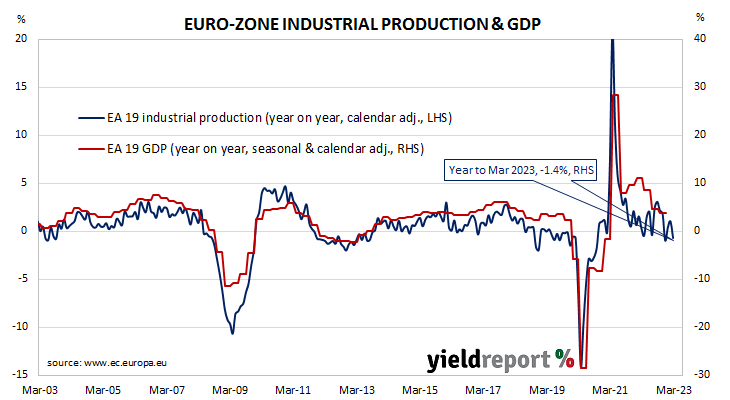Summary: Euro-zone industrial production down 4.1% in March, significantly less than expected; annual growth rate reverses from 1.0% to -1.4%; driven by 26.3% fall in Irish output; German, French 10-year yields creep higher; output contracts in three of four largest euro economies.
Following a recession in 2009/2010 and the debt-crisis which flowed from it, euro-zone industrial production recovered and then reached a peak four years later in 2016. Growth rates then fluctuated for two years before beginning a steady and persistent slowdown from the start of 2018. That decline was transformed into a plunge in March and April of 2020 which then took over a year to claw back. Production levels in more-recent months have generally stagnated in trend terms.
According to the latest figures released by Eurostat, euro-zone industrial production contracted by 4.1% in March on a seasonally-adjusted and calendar-adjusted basis. The result was significantly less than the 2.8% contraction which had been generally expected and in contrast with February’s 1.5% increase. The calendar-adjusted growth rate on an annual basis reversed from February’s revised rate of +2.0% to -1.4%.
ANZ senior economist Catherine Birch noted the fall was driven by 26.3% fall in Irish industrial production which subtracted over 3.0 percentage points. Overall, production of capital goods and intermediate goods both fell while consumer goods production increased.
German and French sovereign bond yields crept a little higher on the day despite the figures. By the close of business, German and French 10-year yields had both added 1bp to 2.30% and 2.87% respectively.
Industrial production contracted in three of the euro-zone’s four largest economies. Germany’s production decreased by 3.1% over the month while the comparable figures for France, Spain and Italy were -1.1%, +1.4% and -0.6% respectively.


